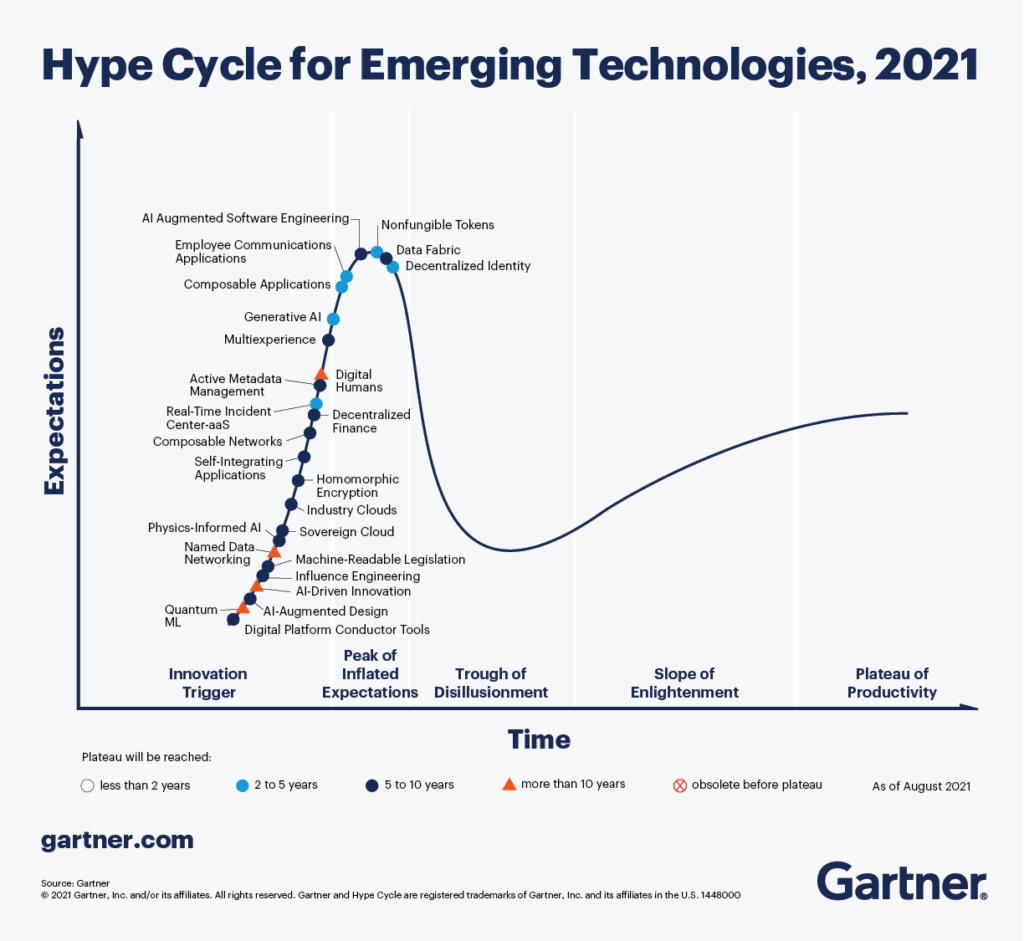By Brian Burke, Research Vice President Gartner Inc
Nonfungible tokens (NFTs), digital humans and physics-informed AI join the 25 technology profiles on this year’s emerging technologies hype cycle.
Earlier this year, Christie’s announced two major firsts for an auction house: It would accept cryptocurrency, and it would offer for sale a purely digital work backed by a unique nonfungible token (NFT).
The work, by digital artist Beeple, sold for more than $69 million. It forms part of an entirely new means of monetization — and potentially a whole new digital ecosystem.
An NFT is a unique blockchain-based digital asset that links to real-world assets like digital art or music and tokenized physical assets like houses or cars. In the case of art, the NFT verifies provenance, ownership and access. NFTs use immutable public blockchains and, as of last month, had a market valuation greater than $300 million.
Download Now: 2020-2022 Emerging Technology Roadmap for Large Enterprises
NFTs are also one of the additions to the Gartner Hype Cycle for Emerging Technologies 2021, which highlights the 25 breakthrough technologies that will have the most significant effect on business and society over the next two-to-ten years.
Listen Now: Behind the Research: The Gartner Hype Cycle
“Breakthrough technologies are continually appearing, challenging even the most innovative organizations to keep up,” says Brian Burke, Research Vice President, Gartner. “Your focus on digital business transformation means you must accelerate change and cut through the hype surrounding these technologies.”
This year’s technologies, selected for their potential transformational benefits and broad potential impact, fall under three main themes:
- Engineering trust
- Accelerating growth
- Sculpting change

Theme 1: Engineering trust
For IT teams to effectively lead technology-enabled business transformation, they must engineer a trusted business core. Trust requires security and reliability, but must also be built on working practices that are repeatable, proven, scalable and innovative. These practices establish a resilient core and foundation for IT to deliver business value.
For example, real-time incident command centers as a service improve situational awareness for organizations by fusing together information from various sources. Typically a public safety organization has some more manual way of integrating databases, sensors, video, and communications systems for an emergency command center.
However, the as-a-service offering simplifies the real-time function of a command center. Initial interest came from creating next-generation real-time centers to reduce crime. However, use cases have expanded to include wildfire management, natural disasters, special events, and — particularly relevant — pandemic response.
The major challenge with this technology is the required amount of interagency cooperation. All of this data (i.e., databases, radio, IoT, mass notifications, license plate readers and geolocation tracking) is typically owned by separate entities. Nevertheless, real-time incident command centers as a service could improve emergency response.
Read More: Data Fabric Architecture is Key to Modernizing Data Management and Integration
Other technologies in that fall into the engineering trust bucket include sovereign cloud, homomorphic encryption and data fabric.
Theme 2: Accelerating growth
With a trusted business core in place, you, as IT leaders and CIOs, must focus on initiatives that drive the organization’s growth. That means balancing technology risk with the appetite for business risk, and ensuring that organizational growth targets are near-term and achievable.
Consider digital humans, which are digital-twin representations of people. This technology presents an opportunity for licensed personas that enable new revenue streams. They can appear as avatars, humanoid robots or conversational user interfaces, like chatbots or smart speakers. These interactive, AI-driven representations seem human and behave in “humanlike” ways supported by a range of technologies including conversational UI, CGI and 3D real-time autonomous animation.
Use cases abound for these humanoid technologies in HR training, communications, medical care and customer service. COVID-19 has pushed the technology potential to enable no-touch experiences, combat social isolation and provide care to the elderly. Digital humans have appeared in feature films, performed at conferences and acted as brand influencers. Societal roadblocks and ethical concerns, in addition to immature technologies, create challenges for digital humans, but the potential for business impact and differentiation is pushing some organizations to pursue this technology.
Other emerging technologies that fall under accelerating growth include multi-experience, industry cloud and quantum ML.
Theme 3: Sculpting change
Change is naturally disruptive. The key is to recognize the disruption, and embrace technologies to sculpt the shift and bring order to what otherwise may be chaos. You must anticipate and influence change to mitigate risk.
For example, physics-informed AI (PIAI) is AI that can build physically and scientifically sound AI models. PIAI has garnered particular interest as a more efficient option for modeling complex systems like climate and environmental issues, which are challenging to model given their scale.
Read More: How to Make AI Trustworthy
Traditional digital AI models have limited adaptability, because they can’t generalize beyond the data they were trained on. PIAI creates a more reliable representation of the context and physical product. COVID-19 highlighted the vulnerabilities of business models that are too brittle. PIAI creates a more flexible representation of the context and conditions in which systems operate, allowing developers to build more adaptive systems. It can also create more robust and adaptable business simulation systems, which are more reliable for a wider range of scenarios.
Other emerging technologies in this area include composable applications, composable networks and influence engineering.
โดย นายไบรอัน เบิร์ค รองประธานฝ่ายวิจัย การ์ทเนอร์ อิงค์
สินทรัพย์ดิจิทัลที่ทำซ้ำไม่ได้ (Nonfungible tokens – NFTs) มนุษย์ดิจิทัล (Digital Humans) และ Physics-Informed AI เข้ามาร่วมเป็น 25 เทคโนโลยีในวงจรเทคโนโลยีเกิดใหม่ของปีนี้
เมื่อต้นปีบริษัทรับจัดประมูลชั้นนำอย่าง “คริสตีส์” ได้เปิดประมูลผลงานชิ้นเอกสองชิ้น ซึ่งการประมูลครั้งนี้เปิดรับสกุลเงินดิจิทัล (Cryptocurrency) ด้วย พร้อมยังเสนอขายงานศิลปะที่สร้างสรรค์ด้วยดิจิทัลโดยใช้เทคโนโลยี nonfungible token (NFT)
ผลงานของศิลปินดิจิทัล “บีเพิล (Beeple)” สามารถขายได้สูงกว่า 69 ล้านดอลลาร์สหรัฐฯ (หรือประมาณ 2,300 ล้านบาท) ซึ่งนี่เป็นส่วนหนึ่งของวิธีการสร้างรายได้แบบใหม่ และมีแนวโน้มที่จะกลายเป็นระบบนิเวศดิจิทัลใหม่ทั้งหมด
NFT เป็นสินทรัพย์ดิจิทัลบนบล็อกเชนที่มีความเฉพาะตัวและเชื่อมโยงกับทรัพย์สินในโลกความเป็นจริง เช่น ศิลปะดิจิทัลหรือดนตรีดิจิทัล รวมถึงสินทรัพย์ต่าง ๆ ที่จับต้องได้และแปลงเป็นเหรียญโทเคน อาทิ บ้านหรือรถยนต์ ในกรณีของผลงานศิลปะ เทคโนโลยี NFT จะตรวจสอบที่มา ความเป็นเจ้าของ และการเข้าถึง ซึ่ง NFTs จะใช้บล็อกเชนสาธารณะที่ไม่สามารถแก้ไขหรือดัดแปลงได้ ในเดือนที่ผ่านมาตลาดนี้มีมูลค่าสูงมากกว่า 300 ล้านดอลลาร์สหรัฐฯ (หรือประมาณ 1 หมื่นล้านบาท)
ดาวน์โหลด: 2020-2022 Emerging Technology Roadmap for Large Enterprises
NFTs ยังเป็นหนึ่งในเทคโนโลยีเกิดใหม่ที่เพิ่มเข้ามาในวงจรการพัฒนาเทคโนโลยีเกิดใหม่ของการท์เนอร์ในปี 2564 ซึ่งแสดงให้เห็นว่ามีเทคโนโลยีสุดล้ำถึง 25 รายการที่จะส่งผลกระทบอย่างยิ่งใหญ่ต่อการทำธุรกิจและสังคมในช่วงสองถึงสิบปีข้างหน้านี้
คลิกฟัง: Behind the Research: The Gartner Hype Cycle
นายไบรอัน เบิร์ค รองประธานฝ่ายวิจัยของการ์ทเนอร์กล่าวว่า “มีเทคโนโลยีล้ำหน้าเกิดขึ้นอย่างต่อเนื่องและเป็นความท้าทายแม้กระทั่งองค์กรที่เน้นนวัตกรรมเป็นหลัก ซึ่งการที่องค์กรต่าง ๆ มุ่งเน้นเรื่องการเปลี่ยนผ่านธุรกิจไปสู่ดิจิทัลหมายความว่าคุณต้องเร่งสปีดในการเปลี่ยนแปลงและก้าวข้ามผ่านเทคโนโลยีที่กำลังมาแรงเหล่านี้ด้วย”
เทคโนโลยีต่าง ๆ ในปีนี้ นั้นได้รับการคัดเลือกโดยพิจารณาถึงศักยภาพในการสร้างประโยชน์ต่อการเปลี่ยนแปลงและผลกระทบที่อาจเกิดขึ้นในวงกว้าง ภายใต้ 3 แกนหลัก ดังนี้:
- ความน่าเชื่อถือทางวิศวกรรม (Engineering trust)
- การเติบโตอย่างเร่งด่วน (Accelerating growth)
- การเปลี่ยนแปลงที่เป็นรูปร่าง (Sculpting change)

ธีม 1: ความน่าเชื่อถือทางวิศวกรรม
ทีมไอทีในฐานะผู้นำการเปลี่ยนผ่านธุรกิจไปสู่ดิจิทัล พวกเขาจะต้องออกแบบและพัฒนาแกนหลักของธุรกิจให้เป็นที่มั่นใจให้ได้ ซึ่งต้องมีทั้งความปลอดภัยและความน่าเชื่อถือ และต้องสร้างขึ้นโดยยึดแนวทางปฏิบัติในด้านการทำงานที่สามารถทำซ้ำ พิสูจน์ ปรับขนาดได้ และมุ่งเน้นนวัตกรรม โดยแนวทางปฏิบัติเหล่านี้จะสร้างแกนหลักและรากฐานธุรกิจที่มีความยืดหยุ่นสำหรับไอทีเพื่อส่งมอบคุณค่าทางธุรกิจต่อไป
ตัวอย่างเช่น ศูนย์บัญชาการเหตุการณ์แบบเรียลไทม์เป็นบริการหนึ่งที่ช่วยให้รับทราบสถานการณ์เกี่ยวกับองค์กรโดยรวมข้อมูลจากแหล่งต่าง ๆ เข้าไว้ด้วยกัน โดยทั่วไปแล้ว องค์กรด้านความปลอดภัยแบบสาธารณะจะมีวิธีการเก็บรวบรวมฐานข้อมูล เซ็นเซอร์ วิดีโอ และมีระบบสื่อสารของตนสำหรับสร้างเป็นศูนย์บัญชาการฉุกเฉิน
อย่างไรก็ตาม บริการนี้ยังช่วยลดความซับซ้อนของฟังก์ชันเรียลไทม์ของศูนย์บัญชาการ โดยเริ่มต้นมาจากการสร้างศูนย์เรียลไทม์ยุคใหม่เพื่อลดปัญหาด้านอาชญากรรม อย่างไรก็ดีมีรูปแบบการนำไปใช้งานที่หลากหลายมากขึ้น อาทิ นำไปใช้ในการจัดการไฟป่า ภัยธรรมชาติ กิจกรรมหรืองานพิเศษต่าง ๆ และโดยเฉพาะอย่างยิ่งรับมือกับการแพร่ระบาด
ความท้าทายสำคัญของเทคโนโลยีนี้คือความร่วมมือระหว่างหน่วยงานที่เกี่ยวข้อง โดยข้อมูลทั้งหมด (อาทิ ข้อมูลพื้นฐาน วิทยุ IoT การแจ้งเตือนจำนวนมาก เครื่องอ่านป้ายทะเบียน และการติดตามตำแหน่งทางภูมิศาสตร์) มักเป็นของหน่วยงานใดหน่วยงานหนึ่ง ถึงอย่างไรศูนย์บัญชาการเหตุการณ์แบบเรียลไทม์ที่เป็นบริการนี้ยังสามารถปรับปรุงและพัฒนาเพื่อรับมือกับเหตุฉุกเฉินได้
อ่านเพิ่มเติมที่ Data Fabric Architecture is Key to Modernizing Data Management and Integration
เทคโนโลยีอื่น ๆ ที่อยู่ในธีม “ความน่าเชื่อถือทางวิศวกรรม” ได้แก่ Sovereign Cloud, Homomorphic Encryption และ Data Fabric.
ธีม 2: การเติบโตอย่างเร่งด่วน (Accelerating growth)
หากแกนหลักธุรกิจมีความน่าเชื่อถือแล้ว ผู้นำไอทีและซีไอโอต้องมุ่งเน้นที่ความคิดริเริ่มใหม่ ๆ สำหรับใช้ขับเคลื่อนการเติบโตให้กับองค์กร นั่นคือการสร้างสมดุลระหว่างความเสี่ยงทางเทคโนโลยีกับความเสี่ยงทางธุรกิจ และต้องสร้างความมั่นใจได้ว่าเป้าหมายการเติบโตขององค์กรยังคงเป็นไปได้และจะบรรลุผลสำเร็จตามแผน
ลองพิจารณาถึง มนุษย์ดิจิทัล (Digital Humans) ซึ่งเป็นตัวแทนของผู้คนในแบบดิจิทัล โดยเทคโนโลยีนี้มอบโอกาสให้กับบุคคลที่ได้รับใบอนุญาตและเปิดช่องทางหารายได้ใหม่ ๆ พวกเขาสามารถเป็นอวาตาร์ หุ่นยนต์ฮิวแมนนอยด์ หรืออินเทอร์เฟซผู้ใช้ในกระดานการสนทนา อาทิ แชทบ็อตหรือลำโพงอัจฉริยะ ซึ่งการโต้ตอบในลักษณะนี้ขับเคลื่อนด้วยเทคโนโลยี AI โดยมีพฤติกรรมแบบเดียวกับมนุษย์ ซึ่งพัฒนามาจากเทคโนโลยีต่าง ๆ รวมถึง UI การสนทนา CGI และแอนิเมชั่น 3 มิติแบบเรียลไทม์อัตโนมัติ
มีรูปแบบการใช้งานเกิดขึ้นมากมายสำหรับเทคโนโลยีฮิวแมนนอยด์ในการฝึกอบรมของฝ่ายบุคคล การสื่อสาร การดูแลทางการแพทย์ และการบริการลูกค้า โควิด-19 ผลักดันศักยภาพของเทคโนโลยีและเปิดประสบการณ์ไร้สัมผัส เพื่อต่อสู้กับความโดดเดี่ยวทางด้านสังคมและการดูแลผู้สูงอายุ มนุษย์ดิจิทัลได้ปรากฏตัวในภาพยนตร์สารคดี แสดงในงานประชุม และทำหน้าที่เป็นผู้มีอิทธิพลต่อแบรนด์ นอกเหนือจากเทคโนโลยีที่ยังพัฒนาไปไม่สุดแล้ว ยังมีอุปสรรคทางสังคมและความกังวลด้านจริยธรรมที่ฉุดรั้งและสร้างความท้าทายให้กับมนุษย์ดิจิทัล แต่ศักยภาพในการสร้างผลกระทบและความแตกต่างทางธุรกิจกำลังผลักดันให้บางองค์กรไล่ตามเทคโนโลยีนี้
เทคโนโลยีเกิดใหม่อื่น ๆ ที่อยู่ภายใต้ธีม “การเติบโตอย่างเร่งด่วน” ได้แก่ Multi-experience, Industry Cloud และ Quantum ML.
ธีม 3: การเปลี่ยนแปลงที่เป็นรูปร่าง (Sculpting change)
การเปลี่ยนแปลงเป็นสิ่งที่เกิดขึ้นโดยธรรมชาติ กุญแจสำคัญคือเราต้องตระหนักถึงการหยุดชะงักและนำเทคโนโลยีมาใช้เพื่อปรับแต่งและจัดการกับสิ่งใดก็ตามที่อาจก่อให้เกิดความปั่นป่วน โดยคุณต้องคาดการณ์และปรับตัวรับการเปลี่ยนแปลงเพื่อลดความเสี่ยง
ตัวอย่างเช่น เทคโนโลยี Physics-Informed AI (PIAI) คือ AI ที่ใช้สร้างแบบจำลองทางกายภาพและทางวิทยาศาสตร์ได้ โดย PIAI ได้รับความสนใจเป็นพิเศษในฐานะตัวเลือกที่มีประสิทธิภาพเพิ่มขึ้นสำหรับการสร้างแบบจำลองในระบบที่มีความซับซ้อน เช่น ปัญหาด้านสภาพอากาศและสิ่งแวดล้อม ซึ่งยากต่อการสร้างแบบจำลองเมื่อพิจารณาจากรายละเอียด
อ่านเพิ่มเติม: How to Make AI Trustworthy
โมเดล AI ดิจิทัลแบบดั้งเดิมมีความสามารถในการปรับตัวที่จำกัด เนื่องจากไม่สามารถสรุปข้อมูลทั่วไปได้นอกเหนือจากข้อมูลที่ถูกป้อนและสอนมา PIAI สร้างรูปแบบการนำเสนอในบริบทของผลิตภัณฑ์ทางกายภาพที่เชื่อถือได้มากขึ้น โควิด-19 ชี้ให้เห็นถึงจุดอ่อนของโมเดลธุรกิจที่เปราะบาง แต่ PIAI สร้างรูปแบบการนำเสนอในบริบทและนำเงื่อนไขต่าง ๆ มาปรับใช้เพื่อช่วยให้ระบบทำงานได้ยืดหยุ่นมากขึ้น ทำให้นักพัฒนาสามารถสร้างระบบที่ปรับเปลี่ยนได้ นอกจากนี้ยังสามารถสร้างระบบจำลองการทำธุรกิจที่มีความแข็งแกร่งและปรับแต่งได้ โดยมีความน่าเชื่อถือสำหรับสถานการณ์ที่หลากหลายยิ่งขึ้น
เทคโนโลยีเกิดใหม่อื่น ๆ ในธีมนี้ ประกอบด้วย Composable Applications, Composable Networks และ Influence Engineering.

